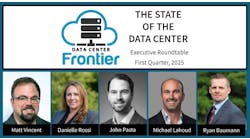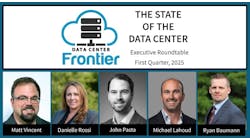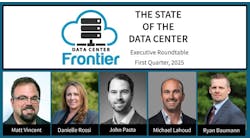AI, VR and Robotics: A Look at the Future of Data Center Automation
It sounds like a science fiction future: huge networks of digital infrastructure, with tens of thousands of severs managed by robots, or perhaps managed by far-away admins using a holographic interface. But here in 2023, with Microsoft and Google launching chatbots and Apple unveiling the Vision Pro VR headset, the future is coming closer every day.
What might the advances in AI, virtual reality and robotics mean for the data center industry, which thrives on automation? That's the question we put to our DCF Executive Roundtable, which had plenty to say on this topic.
Here’s an introduction to our panel of industry experts:
- Joe Goldsmith, Chief Revenue Officer at NTT Global Data Centers Americas.
- Rich Okoney, Global Operations Lead, Data Centers & Critical Environments for JLL.
- Don MacNeil, Chief Revenue Officer for EdgeConneX.
- Adam Compton, Director of Strategy for Schneider Electric.
- Dave Young, Senior VP of Operations for DartPoints.
- Ryan Baumann, Global Director of Sales for Kohler Power Systems.
Here's our conversation.
Data Center Frontier: Data centers have always been highly-automated facilities. What are the most promising opportunities in automation and data center management? Can AI, augmented reality, and robots play a meaningful role?
Rich Okoney, JLL: I believe so. There’s a tremendous amount of untapped potential that can be deployed in robotics, AI and AR in the next five years and beyond. Specifically, with AR, which is already being deployed across many organizations in facility operations and for optimizing training. Augmented reality can be a very effective tool in data center operations as it relates to predictive maintenance, agility in technical training and even incorporating analytics into the platform.
There’s been a tremendous amount of buzz around AI in recent months and it’s a technology that will clearly be a game changer across multiple industries, and even in ways we can’t predict yet. In the data center space, it probably will play a meaningful role, but the applications and innovations are still being developed and it’s too early to tell where it will make the most impact.
Don MacNeil, EdgeConneX: EdgeConneX was founded with its data centers being automated from inception. Our initial Edge facilities were built “lights out” and unmanned, with our proprietary DCIM platform, EdgeOS, built to manage our facilities remotely. This innovation was highly economical and efficient but also proved invaluable during Covid when many customers couldn’t travel to the site(s) where their infrastructure was deployed. We ensured business continuity for our customers during the pandemic and allowed them to remotely manage and operate their infrastructure with the peace of mind of 5 9’s reliability.
We look to continue to automate our facilities as we scale up in size and geographically worldwide. In addition, we are actively trialing numerous technologies to ensure our sites are secure, reliable, and sustainable. Additionally, we are working to provide our customers with more transparency into the sources of grid power – focusing on those sources that are green (solar and wind). By understanding the local environment and weather, we can assist our customers in managing workloads. On a day with no wind or low wind, we could push high power consuming workloads to another day when the wind returns, and the power is therefore “greener.”
Joe Goldsmith, NTT GDCA: The data center industry has always relied on automation technology for efficiency and resilience. The resiliency and availability guarantees that our clients need are not achievable without automation.
Current data center automation tools and systems ensure that power supplies and cooling remain available even when power failures occur. And, providers need to constantly add more automation to keep up with the increasing demands on the data center from higher densities and increased cooling needs.
To keep data centers operating efficiently, building management systems and data center infrastructure management solutions use sensors and other feedback mechanisms to continually monitor and change settings.
These systems have usually relied on traditional fixed algorithms and manual monitoring to function. Examples include:
- Temperature feedback (too hot or too cold) to modify temperature settings
- Airflow sensors that can trigger filter replacements
- Measuring outdoor ambient temperatures, which can affect economization solutions
Now, AI-powered solutions promise to take automation to the next level without relying on isolated systems. They will be able to "learn" how underlying data center systems are related and make modifications that have not previously been considered. So, AI will help build better, more efficient and lower-cost data centers that meet sustainability goals.
Adam Compton, Schneider Electric: I like to contemplate whether data centers can become digitized… Aren’t they, by nature, digitized? However, we all appreciate the complicated human network that enables a data center to function. And unlike a factory machine that traditionally may have shown its failure physically with an immediately identifiable poor output from a faulty part/function, the failure of a data center is invisible, and often slow to manifest itself.
So yes, you can digitize a data center, and we love to do it. We have been in the DCIM business since I started in this industry 25 years ago by ensuring there was graceful network shutdown, and the ability to communicate with a UPS’s higher thinking via SNMP. Naturally the sophistication has multiplied in 25 years. Today the value of a data center management tool starts with the design – designing systems that integrate both physically and digitally.
A good DCIM offer allows for Planning & Modeling for the optimization of critical IT infrastructure. And of course, no DCIM product can call itself worthy unless it can Monitor and Manage critical infrastructure. A solution that has been iterating and concentrating solely on the management of the critical infrastructure for >25 years will have what the modern data center operator needs to design, build, operate, and maintain a data center of any size in any location.
The future will include preventative and prescriptive services, and the future is now. The future will also enable a CIO to answer new vital questions like what is the energy efficiency of my data centers, and what is the carbon footprint of my data centers. And that future is also now.
Dave Young, DartPoints: Automation in data center management has been a significant trend with promising industry opportunities. Facilities infrastructure has benefited from developing IoT devices capable of providing large amounts of telemetry data that aid facility management. These data sets, coupled with AI, will shift the operations from a reactionary approach to predictive management that uses automated elements to optimize performance. Additionally, data analytics will provide valuable information on performance, capacity, and usage patterns that drive proactive decision-making for DartPoints using automated features.
AI, augmented reality, and robots will play a role in enabling data centers to become more efficient and effective. The compilation of these technologies will have a profound impact on the industry. AI will allow data center operators to leverage information that supports maintenance activities, optimization, capacity planning, network management, security and threat detection, and infrastructure management. AR will provide real-time information for remote-hands, visualizations, training, and support activities. Robots will quickly become prevalent in physical security; however, they will quickly adopt AR roles, such as physical rounds, environmental monitoring, and remote operations. These developing technologies will change the industry and influence how data center operators manage their environments.
Ryan Baumann, Kohler: Across all industries, it’s important to stay open to innovations and advancements that can improve automation and efficiency. AI is no different. If implemented correctly, AI compute will continue to drive and further accelerate the needs of the data center landscape, touching a variety of aspects including improved performance, security and the optimization of configurations and deployments.
NEXT: How will the data center industry build the workforce of the future?
Keep pace with the fact-moving world of data centers and cloud computing by following us on Twitter and Facebook, connecting with DCF on LinkedIn, and signing up for our weekly newsletter.






